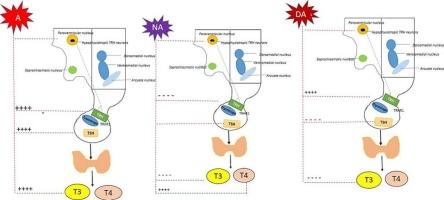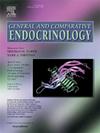Catecolaminergic systems and hypothalamic-pituitary-thyroid (HPT) axis: adrenaline, noradrenaline and dopamine treatments in vivo in lizard Podarcis siculus
IF 1.7
3区 医学
Q3 ENDOCRINOLOGY & METABOLISM
引用次数: 0
Abstract
The catecolaminergic system, which uses dopamine, noradrenaline and adrenaline as neurotransmitters, originates in the brainstem nuclei and spreads widely throughout the central nervous system (CNS). Although there are data indicating that interactions between the catecolaminergic systems of the nervous system and hypothalamic-pituitary-thyroid axis do indeed take place and may be of physiological and clinical relevance, such interactions are far from being clarified. In this paper, we studied the hypothalamic-pituitary-thyroid axis responses in lizards treated with adrenaline, noradrenaline and dopamine respectively. Adrenaline raised plasma TRH and TSH levels and induced a stimulatory effect on the thyroid gland activity with an increase of T3 and T4 levels. On the contrary, noradrenaline treatment induced a reduction in TRH secretion, accompanied by a normal circulating TSH level and increased plasma T4 levels but with a reduction of circulating T3 levels. Dopamine stimulated TRH secretion centrally but induced TSH deficiency followed by reduction of circulating T3 and T4 levels. Furthermore, the effects of the catecolaminergic system on the TRH-TSH-thyroid hormone axis has been also manifested through mechanisms in peripheral organs such as the liver. The dynamic interplay between TRH and TSH and the feedback effects on circulating thyroid hormones after treatment with adrenaline, noradrenaline and dopamine is a very sophisticated and complicated mechanism that responds via afferent inputs from neurons originating in the paraventricular nucleus and can influence the secretion of TRH and TSH-secreting hypophysiotropic neurons with consequent feedback on thyroid hormones.

儿茶酚胺能系统和下丘脑-垂体-甲状腺(HPT)轴:肾上腺素、去甲肾上腺素和多巴胺在蜥蜴体内的作用。
儿茶酚胺能系统以多巴胺、去甲肾上腺素和肾上腺素为神经递质,起源于脑干核,并在整个中枢神经系统(CNS)中广泛传播。虽然有数据表明神经系统儿茶酚胺能系统与下丘脑-垂体-甲状腺轴之间的相互作用确实发生,并且可能具有生理和临床相关性,但这种相互作用远未被阐明。本文分别研究了肾上腺素、去甲肾上腺素和多巴胺对蜥蜴下丘脑-垂体-甲状腺轴的影响。肾上腺素升高血浆TRH和TSH水平,并通过增加T3和T4水平诱导甲状腺活性的刺激作用。相反,去甲肾上腺素治疗导致TRH分泌减少,同时循环TSH水平正常,血浆T4水平升高,但循环T3水平降低。多巴胺刺激TRH中枢分泌,但诱导TSH缺乏,随后循环T3和T4水平降低。此外,儿茶酚胺能系统对trh - tsh -甲状腺激素轴的影响也通过肝脏等外周器官的机制表现出来。肾上腺素、去甲肾上腺素和多巴胺治疗后,TRH和TSH之间的动态相互作用以及对循环甲状腺激素的反馈作用是一个非常复杂的机制,它通过源自室旁核的神经元的传入输入来响应,并影响TRH和分泌TSH的垂体性神经元的分泌,从而对甲状腺激素产生反馈。
本文章由计算机程序翻译,如有差异,请以英文原文为准。
求助全文
约1分钟内获得全文
求助全文
来源期刊

General and comparative endocrinology
医学-内分泌学与代谢
CiteScore
5.60
自引率
7.40%
发文量
120
审稿时长
2 months
期刊介绍:
General and Comparative Endocrinology publishes articles concerned with the many complexities of vertebrate and invertebrate endocrine systems at the sub-molecular, molecular, cellular and organismal levels of analysis.
 求助内容:
求助内容: 应助结果提醒方式:
应助结果提醒方式:


